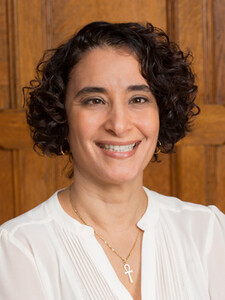Sentencing and Rehabilitation: A Q&A with Professor Gohara
Clinical Associate Professor Miriam Gohara spent 16 years representing death-sentenced clients in post-conviction litigation, first as assistant counsel at the NAACP Legal Defense Fund (LDF) and then as a specially designated federal public defender with the Federal Capital Habeas Project. She teaches and writes about capital and non-capital sentencing, incarceration, and the historical and social forces implicated in culpability and punishment. She leads the Challenging Mass Incarceration Clinic4.

My new paper, “Narrating Context and Rehabilitating Rehabilitation: Federal Sentencing Work in Yale Law School’s Challenging Mass Incarceration Clinic,” is the third in a series that builds on a theory I developed while practicing capital postconviction litigation. That theory proposes that just as defense lawyers’ intensive, interdisciplinary investigation and presentation of capital defendants’ life histories saves their lives from the death penalty, the same quality of social history mitigation can spare noncapital defendants years in prison. In my capital practice, I learned that invariably my clients had survived extreme violence, poverty, and neglect well before they ever harmed anyone else. When capital litigators win life sentences, it is because they have done two things: they have investigated, presented, and explained the behavioral impacts of the extremely adverse experiences their clients have survived; and they have shown that their clients have the capacity for rehabilitation and redemption, even if they serve the rest of their lives in prison. I began to toy with the idea that noncapital defense attorneys should do the same for their clients in order to persuade judges to mete out sentences that account for defendants’ own lifetime adversity and provide a meaningful opportunity for rehabilitation. “Narrating Context” describes how clinic students’ sentencing advocacy explains our clients’ life experiences and demonstrates that rehabilitating our clients outside of prison promotes lasting public safety by addressing the underlying deprivations that have contributed to their crimes in the first place.
What are some of the highlights of the clinic work?
Since the Challenging Mass Incarceration Clinic began in September 2016, Yale Law students have, along with the Federal Defender’s Office for the District of Connecticut, represented 10 clients in federal sentencings. The clinic’s clients have been sentenced to an average of five years below the bottom range of the Federal Sentencing Guidelines. In four of the 10 cases, the clinic students’ advocacy has persuaded judges that alternatives to prison are proportionate, sufficient, and effective sentences for our clients. That has made an enormous difference to clients who have, as a result, been able to receive drug treatment, mental health services, begin or continue law-abiding employment opportunities, and continue to support their families. Most recently, the clinic’s work uncovered the reason that a client in his 30s who had pled to narcotics dealing had been unable to succeed educationally or in traditional employment settings. The students’ investigation of his educational records and social history gave an expert psychologist enough information to diagnose him with intellectual disability, which opened up a world of rehabilitative options and disability supports for our client, none of which he would have received in prison. The students’ brief and our client’s incredibly hard work at achieving his sobriety and participating in appropriate work and educational programs persuaded the court to sentence him to three months of time served in jail, instead of the 63 months of prison he was facing at the low end of the Sentencing Guidelines, which the prosecutor had recommended.
You have written about your work with an innovative program in a Connecticut prison that is modeled on German approaches to rehabilitation. Can you tell us more about that?
I was enormously gratified to receive an Oscar M. Ruebhausen grant from YLS to travel to three prisons in Germany to learn about their approaches to rehabilitating the people in their custody. My interest was sparked by my clinic students’ work with clients in a unit modeled on German programs here in Connecticut at the Cheshire Correctional Institution. Our clients are men serving decades-long or life sentences whom the Department of Correction has hired to provide counseling, educational, and life-skills mentoring to younger men incarcerated in the unit. Their work is based on the German ideal that incarceration is punishment enough and that the conditions of incarceration should rehabilitate and heal people in custody rather than cause further harm. The program, which has garnered national attention from outlets like The Marshall Project and 60 Minutes, has transformed the lives of our clients and the young men they mentor. All the mentors have been trained in trauma-informed communication and mentoring. Some have earned college degrees; others have participated in restorative justice programs. Our clinic is advocating for a second chance at life in the free world for these clients in whom the DOC has placed enough faith and trust to hire them to rehabilitate others. Working with these remarkable clients has been transformative for clinic students and has informed my research and writing about healing clients’ trauma through creative defense lawyering.


